Brajagopal Majumder
Department of Physics, Government Degree College, Agartala, Tripura, India
Correspondence to: Brajagopal Majumder, Department of Physics, Government Degree College, Agartala, Tripura, India.
| Email: |  |
Copyright © 2018 The Author(s). Published by Scientific & Academic Publishing.
This work is licensed under the Creative Commons Attribution International License (CC BY).
http://creativecommons.org/licenses/by/4.0/

Abstract
It is to be noted that protein vibration has been playing a pivotal role in controlling structural changes. Thus observation and identification of these vibrations are getting priority day by day. But it is very hard to conduct experiments in vivo phase with living animals particularly human to investigate and to identify protein vibration. Scientists of the day are giving priority in devising suitable tools for observation of protein vibration in vivo phase subject to that a thought experiment based on resonance phenomenon has been designed here. Through this it is expected that vibration of protein can be investigated and hence measuring of vibration frequency can be undertaken even indirectly in near future. For example, points of resonance frequency due to vibrations of Heat Shock Protein – 70 and those of aggregated alpha synuclein proteins where disaggregation of aggregated proteins may occur, have been suggested in this paper with scope of determining maximum amplitudes.
Keywords:
Protein Vibration, Resonance frequency, Aggregated Proteins, Heat Shock Protein -70
Cite this paper: Brajagopal Majumder, Designing a Thought Experiment on the Role of Resonance Generated Due to Protein Vibration, Journal of Microbiology Research, Vol. 8 No. 4, 2018, pp. 91-96. doi: 10.5923/j.microbiology.20180804.01.
1. Introduction
Vibration of proteins either due to the presence of electrostatic potential in the cells or due to external stimuli has now-a-days constitutes a new channel of studying the properties of proteins. In vivo investigation relating to the characteristics of proteins particularly in mammalian body is still hard to conduct. However, scholars of the days are toiling their best to conduct in vivo experiment in the laboratory with different worms, insects and mice. Studying disaggregation of aggregated proteins of different types in laboratory atmosphere is being conducted by a number of scholars. Recently, Aamir Nazir and others [1] conducted an in vivo experiment with aggregated worms NL5901 by alpha synuclein proteins responsible for Parkinson disease (P.D), which is found to get disaggregated when it was treated with the extract of Bacopa Monnieri (B.M). Similar experiments were conducted with respect to disaggregation of tau protein aggregated with its isomers responsible for Alzheimer disease [2] and huntingtin protein responsible for Huntington disease [3] taking into account the affected mice with Alzheimer and Huntington diseases. These experiments were however laboratory based in vivo studies for disaggregation of tau protein and also of huntingtin protein when the experimental mice were treated with extract of Ashwaganda and Curcumin. Since no specific explanation was made by the scholars on the process of therapeutic activity of the affected proteins induced by Indian medicinal herbs, the author conducted analytical study on this aspect in the light of protein vibrations approach [4] and held the view that the disaggregation of aggregated proteins could be occurred due to vibration of both affected protein and H.S.Ps induced after administration of the extract of Indian medicinal herbs. No experimental evidences on the role of protein vibration due to inherent electrostatic potential or external stimuli are available till the day. However, some scholars are trying to measure the magnitude of protein vibration in vitro experiment in laboratories. Recently, development in this field may be attributed to the credit of K.A. Niessen and others [5] who tried best to measure the magnitude of protein vibration in laboratory. The scholars showed “optical observation of long range protein vibration modes by orientation of sensitive terahertz near field microscopy measurements of chicken egg white lysozyme single crystals with group molecular weights of 100 Da”. The scholars observed underdeveloped modes of protein vibration with frequencies >10cm-1. These are as the scholars held, found to be lower than the cut off frequencies predicted by normal mode calculations [6] and others [7]. Implementation of this method, as the scholars held, may be considered as the first step towards evaluating the functional relevance of the protein – correlated structural motions [5]. Since the scholars conducted the experiment in vitro stage, some inherent properties of protein like electrostatic potential of the cell which influences the vibration mode of protein, could be taken into consideration. However, their aim and objective were to observe the protein vibration in vitro stage. Their attempt may be succeeded. But it is true if light of terahertz frequency falls on a crystal, it is expected that vibration will be generated. In this crucial juncture, our analytical approach on protein vibration particularly with respect to disaggregation of aggregated protein has opened a new channel to the therapeutic role of resonances generated due to frequency matching of vibration of foreign and native proteins particularly with respect to some old age diseases.
2. Back Ground of the Thought Experiment
Now, it is an established fact that protein vibrates due to either electrostatic force (potential) or due to external stimuli. The authors in a paper [4] suggested that the vibration characteristics of protein depend on the magnitudes of molecular weights of the concerned protein. It was also held by the authors that more the molecular weight of protein, the less is the number of vibration frequency. On the other hand, less the value of molecular weight of protein is, the more is the number of frequency. Thus the vibration pattern of protein may be described as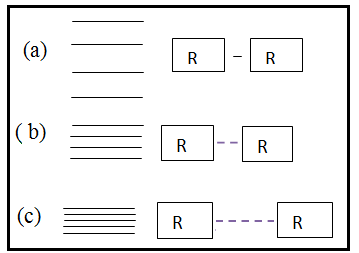 | Figure 1. Vibration energy spacing of protein molecules |
The vibration frequency and vibration energy of the concerned protein can be evaluated by using one dimensional Schrodinger’s Equation. The reason of considering one dimensional Schrodinger’s Equation lies in the fact that an electrostatic force can control atomic motion in a protein. For a protein this can be divided into two components – a large and a small.Conformational substrates for the protein in its native state may correspond to the same position ‘r’ of the particle at time‘t’. Thus r (t) can be split into two independent components. r(t) = rv (t) + rt (t)Where rv (t) stands for the vibration component about the equilibrium position with the host molecule and rt (t) stands for transient component about the equilibrium position at time t. The electrostatic force required for this purpose may be deduced from the relationf = -dv/drWhich means force is nothing but rate of change of potential | (1) |
Where Kvr1 is the vibration component of the force and U (r) stands for the translational component of the same. Since the translational component of the force is very small with respect to the vibration component of the same, the second term of equation (1) may be neglected. So equation (1) may be rewritten as  | (2) |
The magnitude of this transformed energy may be evaluated by following quantum mechanical treatment of harmonic oscillator. By inserting vibration potential energy function, we may write f = -dv / dr, which stands for the rate of change of potential energy with change of co-ordinate. Let us now state f = - kr which on integration leads to potential energy v = ½ kr². This potential energy rises parabolic on either side of the equilibrium as illustrated in Fig. 2.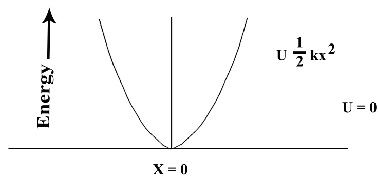 | Figure 2. Oscillation of vibrating particle |
The vibration energy and vibration frequency of concerned proteins may be evaluated by using the solution of one dimensional Schrodinger’s Equation | (3) |
which turns to  | (4) |
with potential energy  , while other symbols stand for usual meaning.The energy of the allowed vibration states derived from the solutions of the Schrodinger’s Equation are
, while other symbols stand for usual meaning.The energy of the allowed vibration states derived from the solutions of the Schrodinger’s Equation are | (5) |
While the expression for vibration frequency stands as | (6) |
Based on equation (6) and (5), Vibration frequencies of a good number of proteins generated due to inherent electrostatic force of the order of (.8 to 30) mv or due to external stimuli in the form of EEG rhythms were calculated by the author. The author examined the role of vibration frequencies and vibration energies in learning and memory formations with the application of EEG rhythms or due to electrostatic force [4, 8-11]. The author also explained the therapeutic application of protein vibration generated due to inherent electrostatic potential particularly with respect to disaggregation of aggregated proteins in case of Parkinson [12], Alzheimer [13] and Huntington [14] diseases for which aggregated alpha synuclein protein, tau protein and huntingtin proteins are respectively responsible. In all the three cases, the role of Heat Shock Protein – 70 induced by the body cells of the above three categories of patients when they were administrated the extract of Bacopa Monnieri (BM), Ashwaganda and curcumin respectively was taken into account. It was shown by the author that disaggregation is due to frequent vibration frequencies generated by HSP – 70 which are higher or nearly equal with those generated by the native proteins like alpha synuclein, tau and huntingtin for Parkinson, Alzheimer and Huntington diseases respectively. Here the author attempts to explain the in-depth principle of disaggregation of aggregated proteins based on the role of resonance frequencies generated due to both native and foreign protein vibration.
3. The Feature of Thought Experiment
Now an attempt has been taken by the author to examine the mechanism of disaggregation of aggregated protein by considering the role of resonance generated due to both natural frequency of the native protein (here the aggregated protein) and the interacting protein (here the H.S.P induced after administration of the extract of Indian medicinal herbs like B.M, Ashwaganda and Curcumin as external agents). The author proposes to explain this phenomenon based on the role of resonances generated due to natural vibration of the building and that of the earth plates resulting in breakdown of the buildings etc during earth wake. Scientifically, resonance means – “the increase in amplitude of oscillation of electrical or mechanical system exposed to a periodic force whose frequency is equal or nearly close to the natural undamped frequency of the system”. An example as outcome of resonance phenomenon in the form of earth wake is cited here graphically.  | Figure 3. Relation between frequency and amplitudes as outcome of resonance phenomenon during earth wake (Courtesy Google Communication) |
To examine the phenomenon of resonances thus proposed in case of mammalian proteins existing in body/blood cells is hard or almost impossible particularly in vivo stages. However, some in vivo experiments are being conducted by the scholars with affected worms or insects by treating these with H.S.Ps induced by Indian medicinal herbs or similar other proteins and the magnitudes of disaggregation proteins of are now being observed experimentally in Libratory. A case of disaggregation of alpha synuclein protein by B.M extract as investigated by Aamir Nazir and others [1] are cited here as an example. 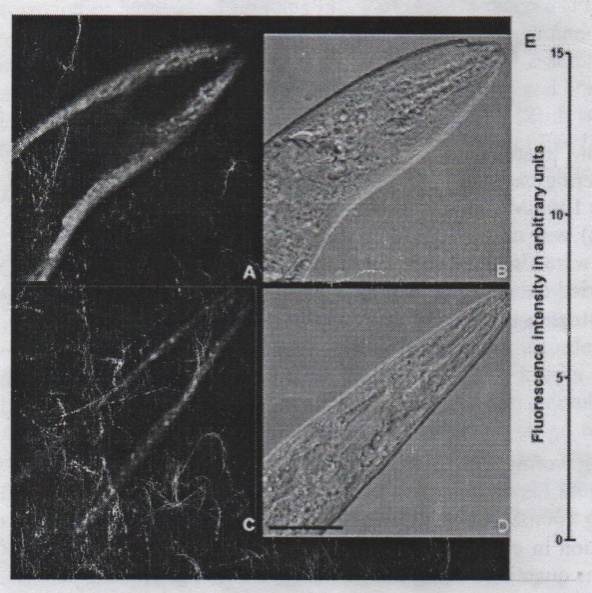 | Figure 4. Alpha synuclein aggregation in NL 5901 strain of C. elegans fed on OP50 (A,B), Bacopa monnieri (C, D) (Courtesy Aamir Nazir & Others) |
In case of in vivo stage of mammalian body, it is thought that resonance occurs with increase in amplitudes when the frequency of interacting protein (foreign protein) is found equal or nearly equal of the native (aggregated) protein. The whole phenomenon of occurring resonances and disaggregation of aggregated proteins in vivo stage may be thought similar to the functioning of a resonator as –The cells of the body with aggregated proteins are thought as resonators. Native proteins in the cells vibrate due to inherent electrostatic force of magnitude (.8 to 30) mv with respect to variable PH [15] at different frequencies. The proteins induced by external stimuli (here H.S.P – 70 induced with administration of herbal extracts) will also vibrate at different frequencies due to some amount of electrostatic force available in the cells. When the magnitudes of frequencies generated due to two types of protein would be equal or nearly close to each other, resonance will occur with increase in amplitudes. As a result, break down of aggregated parts of the protein will occur with or without the native parts as like as breaking down of the walls of the building with or without pillars during earth wake.
4. Results and Discussion
Vibration frequencies of H.S.P – 70 and those of native and aggregated alpha synuclein proteins have been calculated based on eqn. (6) taking into account different magnitudes of electrostatic potential. These are tabled in Table 1.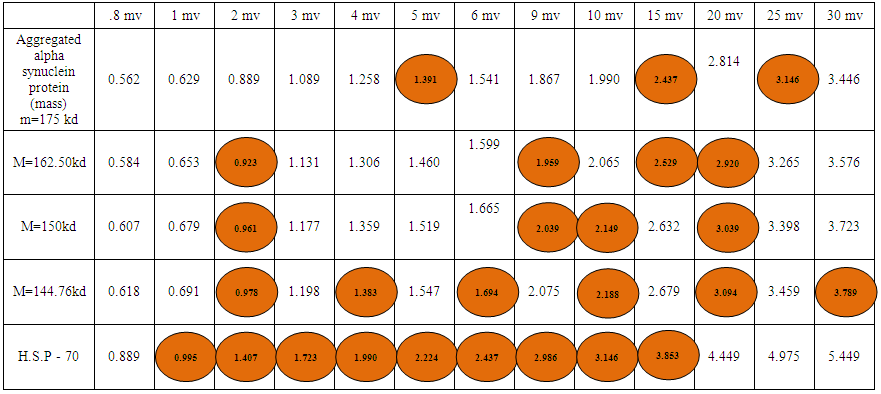 | Table 1. Frequencies (m-1) generated by proteins in presence of electrostatic potential in the order of (0· to 30) mv |
From the table, it reveals that some of the frequencies generated by H.S.P – 70 are found equal or nearly equal to those native and aggregated constituents of alpha synuclein proteins at electrostatic potential of magnitudes 2,3,4,6,9,10,15,25 and 30 mv etc (taken randomly). However, matching points of the frequencies generated due to H.S.P – 70 with those of native and aggregated proteins are marked in the table with colored circles. It also reveals that the frequencies generated due to aggregated alpha synuclein protein of masses like m=175, 162.50, 150 and 144.76 kd (Suggested as resonators in the cell) in presence of electrostatic potential of the order of 1,2 and 3 mv are in good matching with those of H.S.Ps – 70. From this observation, it is held that resonance will occur at these points of natural frequencies with those of H.S.Ps – 70 with high peak of amplitudes and hence disaggregation will start and continue due to some other matching points of natural frequencies and those of H.S.Ps – 70.This means resonance as per scientific definition will occur at the above mentioned points of frequency matching of native and aggregated proteins with those of vibration frequencies of H.S.P – 70.Now let us examine the characteristics of amplitudes of the waves particularly with respect to magnitudes of frequency at the marked points of electrostatic potential.However, analytical formula for determination of amplitudes of a particular wave is limited. From classical point of view, amplitudes can be determined from the expression  | (7) |
Were A stands for amplitude, D is the distance travelled by a wave and F is the frequency of the wave. Amplitudes can also be determined from vibration energy since vibration energy is directly proportional to the square of the amplitude which means energy  were A stands for amplitude.Again from wave properties, the equation of a wave [16] travelling in the positive x - direction is
were A stands for amplitude.Again from wave properties, the equation of a wave [16] travelling in the positive x - direction is | (8) |
Where  in the angular frequency, k is the propagation constant and x Stands for phase velocity.Similarly, for another wave, we may write
in the angular frequency, k is the propagation constant and x Stands for phase velocity.Similarly, for another wave, we may write | (9) |
The resultant wave is  | (10) |
After some trigonometrical analysis, the eqn. (10) turns to  | (11) |
Again, sin term in eqn. (11) represents a carrier wave with  and hence the amplitude of the resultant wave is given by
and hence the amplitude of the resultant wave is given by  | (12) |
Numerical evaluations of amplitudes of resultant wave are a bit complicated. However, an attempt has been taken here to evaluate the amplitude simply on the basis of the eqn. (7) and the magnitudes of amplitudes thus evaluated for some matching points of occurring resonances (Say 7) are tabled in Table No. 2. Similarly, amplitudes of other matching points may be evaluated. Table 2. Relation between Numerical Values of Frequencies and Corresponding amplitudes
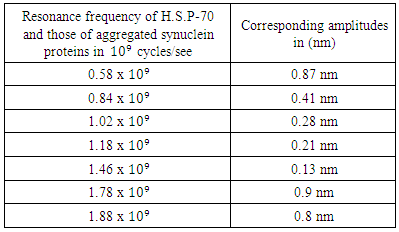 |
| |
|
Graphical representation of the numerical values of frequency Vs amplitudes as mentioned is presented in Fig. 5. | Figure 5. Graphical representation of the numerical values of frequency Vs amplitudes |
(a) indicates happening of frequency resonance in one direction while (b) indicates the same incidence in both the directions which means at any point of matching.These Figs. are found to be compatible with those as found in case of earth wake shown in Fig: 3.
5. Conclusions
It is to be mentioned here that the thought experiment on the role of resonance generated due to protein vibration is based on a number of analytical approaches of vibration frequencies and vibration energies of different proteins, the functioning’s of which have been investigated in case of learning and memory formation and also in case of disaggregation of aggregated proteins. All these works were considered from analytical point of protein vibration and the results thus derived were compared with experimental outcomes in possible cases. To get directly involved in conducting in vivo experiment with respect to protein vibration though a tough challenge, yet scientists of the day are toiling best to conduct investigation on protein vibration. The recent attempt of K.A Niessen and others [5] to investigate the existence of protein vibration in vitro experimental arrangement may throw some light on the characteristics of protein vibration. However, it is held that disaggregation of aggregated proteins will definitely follow the phenomenon of frequency resonance though it is not at this stage possible to examine and explain the characteristics of protein vibration and its aftermath in cell in vivo stage.In view of these, it is expected that if in vivo experimental arrangement can be made based on our postulation of protein vibration, the role of resonance due to matching frequency condition of native and aggregated proteins and those of H.S.P -70 within the cells leading to desired amount of disaggregation like earth wake happenings may be established with the simple difference that earth wake is an instantaneous event while resonance effect of protein vibration may be a slow process and beyond of our common sensitivity.
ACKNOWLEDGEMENTS
The author is thankful to Prof. U.C. De, Depart. of Chemistry, Tripura University for helpful discussion. The author is also thankful to Joysree Sutradhar for undertaking Computer Work.
References
| [1] | Pooja Jadiya, Asif Khan, Shreesh Raj Sammi, Supinder Kaur, Snober S. Mir & Aamir Nazir: Anti-Parkinsonian effects of Bacopa monnieri; insights from transgenic and pharmacological Caenorhabditis elegans models of Parkinson’s disease, Biochemical and Biophysical Research Communications: 413 (4), 605-610. |
| [2] | Sehgal. N, Gupta. A Valli. R.K, Joshi. S.D, Mills. J.T, Hamel. E, Khanna. P, Jain. S.C, Thakur. S.S, Ravindranath. V.: Withania somnifera reverses Alzheimer’s disease pathology by enhancing low – den sity lipoprotein receptor – related protein in liver. PNAS, USA, 109, 9 (2002). |
| [3] | Bala K, Tripathy BC, Sharma D: Neuroprotective and anti-ageing effects of curcumin in aged rat brain regions. Biogerontology 7: 81-89. (2006). |
| [4] | Majumder B.G, De U.C.: Role of Protein Vibration In Learning and Memory – A mathematical Approach. International Journal of Biophysics. 3(1), 33-37 (2013). |
| [5] | Gheorghe Acbas, Katherine A. Niessen, Edward H. Shell & A.G. Markelz: Optical measurements of long-range protein vibrations, Nature Communication: 5, 3076, 16, Jan (2014). |
| [6] | Smith, J., Cusack, S., Tidor, B. & Karplus, M. Harmonic and damped harmonic models of bovine pancreatic tryspin inhibitor. J. Chem. Phys. 93, 2974-2991 (1990). |
| [7] | Meinhold, L. & Smith, J.C. Protein dynamics from X-ray crystallography: anisotropic, global motion in diffuse scattering patterns. Prot. Struct. Funct. Bioinf. 66, 941-953 (2007). |
| [8] | Majumder BG,: Role of Locally Synthesied Protein in Long Term Memory-An Analytical Approach, International Journal of Biophysics. 4(1), 1-8, (2014). |
| [9] | Majumder BG,: Smelling – A Pathway to Instant Memory. International Journal of Biophysics. 4(1), 16-22, (2014). |
| [10] | Majumder BG,: Role of Protein Vibration in Emotion Attention, Learning and Memory, International Journal of Biophysics, 5(1), 1-11 (2015). |
| [11] | Majumder BG; Majumder A.: Role of Protein Vibration in Convergent and Divergent Thinking with Respect to Student’s Performances, Open Access Library Journal, 4, e3645, 1-15, (2017). |
| [12] | Majumder BG: An Analytical Approach to Anti – Parkinsonian Effect of Bacopa Monnieri in the Context of Protein Vibration, International Journal of Biophysics, 6(2), 21-25, (2016). |
| [13] | Majumder BG: Role of Protein Vibration in Anti – Alzheimer’s Effect of Ashwagandha (Withania Symnifera) – An Analytical Approach, International Journal of Biophysics, 7(3), 41-47, (2017). |
| [14] | Majumder BG : Activation of Heat Shock Protein induced by Curcumin to Prevent Huntington Disease –an Analytical Approach in the Context of Protein Vibration, International Journal of Biophysics, 8(1), 1-8, (2018). |
| [15] | Siva Sankar, S.S, Subramaniam. S and Leckband, D.: Direct Molecular level measurement of Electrostatic potential of a protein surface. Proc. Natl. Acad. Sci. USA. 95, 1261-1296 (1998). |
| [16] | Sing, S.P & Badge, M.K.: Quantum Mechanics. S.Chand & Company Ltd. India, 39-41 (1986). |









 , while other symbols stand for usual meaning.The energy of the allowed vibration states derived from the solutions of the Schrodinger’s Equation are
, while other symbols stand for usual meaning.The energy of the allowed vibration states derived from the solutions of the Schrodinger’s Equation are





 were A stands for amplitude.Again from wave properties, the equation of a wave [16] travelling in the positive x - direction is
were A stands for amplitude.Again from wave properties, the equation of a wave [16] travelling in the positive x - direction is
 in the angular frequency, k is the propagation constant and x Stands for phase velocity.Similarly, for another wave, we may write
in the angular frequency, k is the propagation constant and x Stands for phase velocity.Similarly, for another wave, we may write


 and hence the amplitude of the resultant wave is given by
and hence the amplitude of the resultant wave is given by 

 Abstract
Abstract Reference
Reference Full-Text PDF
Full-Text PDF Full-text HTML
Full-text HTML